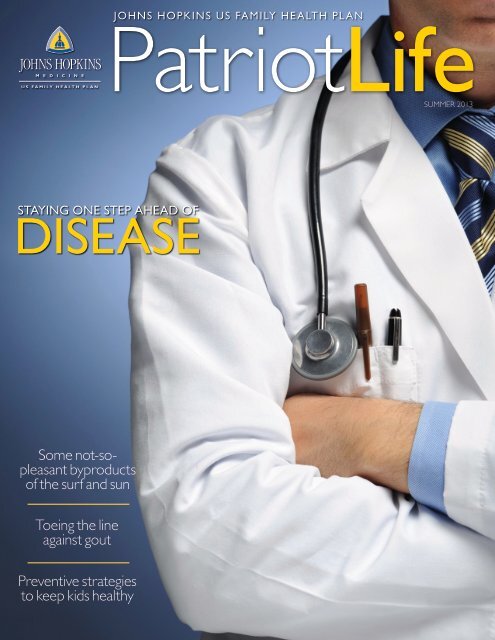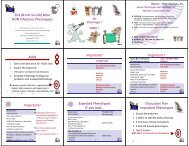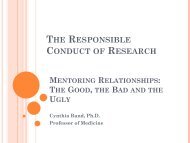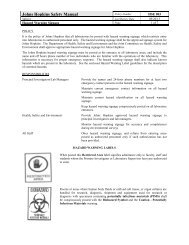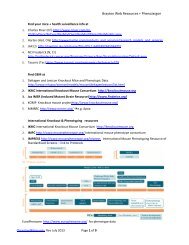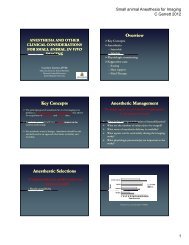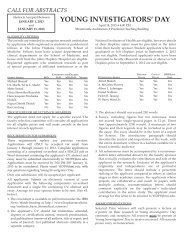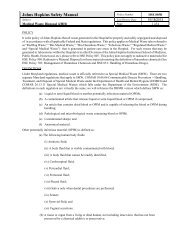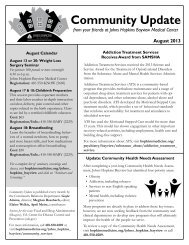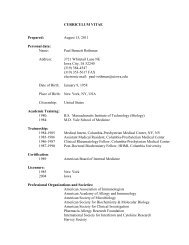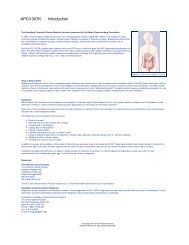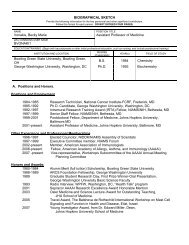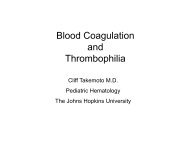DISEASE - Johns Hopkins Medical Institutions
DISEASE - Johns Hopkins Medical Institutions
DISEASE - Johns Hopkins Medical Institutions
You also want an ePaper? Increase the reach of your titles
YUMPU automatically turns print PDFs into web optimized ePapers that Google loves.
JOHNS HOPKINS US FAMILY HEALTH PLAN<br />
PatriotLife<br />
SUMMER 2013<br />
STAYING ONE STEP AHEAD OF<br />
<strong>DISEASE</strong><br />
Some not-sopleasant<br />
byproducts<br />
of the surf and sun<br />
Toeing the line<br />
against gout<br />
Preventive strategies<br />
to keep kids healthy
TO YOUR HEALTH<br />
Not So Fun<br />
Some not-so-pleasant byproducts of the surf and sun.<br />
SWIMMER’S EAR: Develops when excess water, sand or dirt enter the ear<br />
canal, causing inflammation and infection. Symptoms include itching, fullness in<br />
the ear, temporarily muffled hearing and pain.<br />
Treatment: Ease ear pain by applying a warm washcloth. Gently rinse the<br />
ear using a bulb syringe and warm saline solution or a half-and-half solution<br />
of white vinegar and warm water. Contact your doctor if the ear becomes<br />
red, swollen or very painful; dizziness or bleeding/discharge from the ear<br />
develops; or ear symptoms worsen or last longer than a week.<br />
SUNBURN: Caused by the sun’s ultraviolet rays. Most sunburns prompt mild<br />
pain and redness, affecting the outer layer of skin. If skin swells up and blisters,<br />
it could mean that deep skin layers and nerve endings have been damaged.<br />
Treatment: Bathe in lukewarm water or apply cold compresses to the affected<br />
area. Apply aloe or moisturizing lotion. Take pain relievers. Replace<br />
body fluids with water, juice or sports drinks. Call a health care provider<br />
if sunburn occurs in children under age one, fever develops, blisters show<br />
signs of infection, or symptoms become more severe or frequent. To prevent<br />
sunburn, avoid the midday sun (10 am to 4 pm); if you must be outdoors,<br />
wear a wide-brimmed hat and protective clothing, and use plenty<br />
of sunscreen.<br />
For more information visit www.hopkinsmedicine.org/usfhp and click the<br />
button titled A-Z Healthwise.<br />
PUSH BACK AGAINST PULLED MUSCLES<br />
While a pulled muscle can temporarily sideline you, there are easy steps you can take<br />
(and some to avoid) to get back in the game. Here are some treatment dos and don’ts<br />
from the experts in Orthopedic Surgery at <strong>Johns</strong> <strong>Hopkins</strong> Medicine. For more information,<br />
visit http://www.hopkinsortho.org/muscle_strain.html.<br />
DON’T:<br />
• Apply heat too soon. In the first 24 to 48 hours, heat can actually increase swelling.<br />
• Massage too vigorously. Done incorrectly, a massage could exacerbate your injury.<br />
• Return to activity too soon. A damaged muscle is more vulnerable to a worse<br />
injury.<br />
DO:<br />
• Apply ice. It’s best to ice your injured muscle for about 20 minutes, two to three<br />
times daily.<br />
• Take anti-inflammatory medication, such Tylenol, Motrin or Aleve upon direction<br />
from your physician.<br />
• Rest—but not for too long. As soon as you physically can, gradually begin moving<br />
the joints and muscle to prevent stiffness, atrophy and weakness. When you’re<br />
ready, try some light stretching and movement.<br />
• Seek help from a physical therapist or orthopedist, especially for more severe<br />
strains.<br />
Resume regular activities when you can fully move without pain and your strength equals<br />
that of your uninjured side. And don’t forget: Always warm up before stretching to prevent<br />
further injury.<br />
2 • PatriotLife • SUMMER 2013 www.hopkinsmedicine.org/usfhp
Toeing the Line<br />
Against Gout<br />
Wondering what King Henry VIII,<br />
Dick Cheney and Luciano Pavarotti<br />
all have in common?<br />
They’ve all had gout.<br />
A common form of inflammatory arthritis,<br />
gout occurs when excessive uric acid crystals<br />
are deposited into connective tissues and<br />
joints, causing swelling, stiffness, pain, heat<br />
and redness. Once considered a disease fit for<br />
kings—because of its association with overindulging<br />
in food and drink—today gout is no<br />
longer reserved for the well-to-do.<br />
“Today, the demographic can include<br />
people who are overweight, eat foods high<br />
in purine—such as organ meat, sardines or<br />
beer—and have medical conditions like hypertension,<br />
which is a risk factor for gout,”<br />
says Sabiha Khan, M.D., a rheumatologist with<br />
<strong>Johns</strong> <strong>Hopkins</strong> Community Physicians Downtown<br />
Bethesda.<br />
Gout is most commonly seen in men in<br />
their 30s and 40s and women in their 60s.<br />
It can affect any joint, but is most common<br />
in the big toe. “Usually only one joint is affected,”<br />
Khan says, “but it can also affect multiple<br />
joints at once.” Individuals who struggle<br />
with obesity, hypertension or joint trauma<br />
may be particularly at risk, as are those who<br />
use diuretic medications or have family history<br />
of gout.<br />
The condition can cause a fiery pain that<br />
will wake you in the middle of the night and<br />
render the slightest movement unbearable.<br />
Recurrent attacks can cause long-term joint<br />
damage to the joint and high levels of uric acid<br />
can lead to kidney stones.<br />
Gout is treatable. Medications usually include<br />
non-steroidal anti-inflammatory drugs<br />
(NSAIDS), corticosteroids and medications<br />
to block or better process uric acid. Sufferers<br />
should avoid foods that can serve as “triggers,”<br />
including shellfish, beer, hard alcohol<br />
and foods flavored with high fructose corn<br />
syrup.<br />
“While medications can play a big role in<br />
treating gout,” Khan says, “dietary changes<br />
and weight loss can also really help.”<br />
If you are experiencing any symptoms<br />
please contact your primary care physician.<br />
www.hopkinsmedicine.org/usfhp<br />
PatriotLife • SUMMER 2013 • 3
COVER STORY<br />
STAYING<br />
ONE STEP<br />
AHEAD OF<br />
<strong>DISEASE</strong><br />
Even with weight loss programs like the<br />
Paleo Diet and the South Beach Diet<br />
bolstering a billion-dollar diet industry,<br />
chronic disease remains the leading cause<br />
of death and disability across the United<br />
States.<br />
Indeed, 75 percent of the money spent on health<br />
care goes to the treatment of chronic diseases like<br />
Type 2 diabetes and congestive heart failure. And<br />
yet these illnesses are also highly preventable. Of<br />
course, diet and exercise alone can go far in avoiding<br />
a lifetime of poor health. But if you want to<br />
stay a step ahead of disease, your doctor should be<br />
a primary partner, and preventive screenings and<br />
care should be considered mandatory steps in your<br />
pursuit of good health.<br />
“If you don’t go to the doctor, there may be no<br />
one telling you to change the bad habits,” says Alice<br />
Lee, M.D., an internal medicine specialist with<br />
<strong>Johns</strong> <strong>Hopkins</strong> Community Physicians at White<br />
Marsh. “It’s a lot easier to be unhealthy if you don’t<br />
go to the doctor, because you’re basically putting<br />
your head in the sand.”<br />
Perhaps the simplest step toward disease prevention<br />
is a regularly scheduled physical exam. Considered<br />
a staple of preventive medicine, a physical<br />
generally consists of a doctor taking your medical<br />
history, checking your blood pressure, weight, and<br />
other vital signs, examining your body (head, neck,<br />
skin, extremities, etc.) and possibly conducting a<br />
battery of lab tests. While much of the exam focuses<br />
on assessing your current health, your physician<br />
should also screen for disease risk.<br />
4 • PatriotLife • SUMMER 2013 www.hopkinsmedicine.org/usfhp
“If someone comes in for a physical, we always<br />
talk about their history and what kinds of risks they<br />
might have and advise them accordingly,” Lee says.<br />
“If they have a family history of heart disease, we’re<br />
going to be even more likely to recommend a healthier<br />
diet and regular exercise and to encourage them<br />
to monitor their cholesterol and<br />
WHEN IT COMES TO AGE, there’s your chronological<br />
age and there’s your biological, or health age—and<br />
the two don’t always line up.<br />
Determined by issues like weight, disease history, diet<br />
and exercise habits, health age measures the degree<br />
of aging your body has experienced versus how old<br />
you actually are. A healthy-eating 45-year-old aerobics<br />
instructor with no history of chronic illness might have a<br />
health age of 37. Conversely, a 45-year-old smoker who<br />
is overweight might have a biological age of 62.<br />
In this age of obesity and chronic disease, “we see a<br />
lot of people who are older than their actual ages,” says<br />
Wendy Bowen, a health coach with USFHP. “We deal<br />
with a lot of chronic diseases and obesity, and those<br />
patients will be older because of their conditions.”<br />
Smoking, a high-fat diet and a sedentary lifestyle all<br />
increase your disease risk, and likewise, your health age.<br />
The good news? While chronological age moves<br />
relentlessly onward, your health age is less constant. If<br />
you give up your regular trips to McDonald’s or kick the<br />
smoking habit, time can be turned back.<br />
“IF YOU DON’T GO<br />
TO THE DOCTOR,<br />
THERE MAY BE NO<br />
ONE TELLING YOU<br />
TO CHANGE THE<br />
BAD HABITS.”<br />
—ALICE LEE<br />
blood pressure.”<br />
Of course, while some preventive<br />
measures are applicable to<br />
everyone, gender and age can also<br />
play a role. At age 50, for instance,<br />
both men and women should begin<br />
to get screened for colon cancer.<br />
Women ages 18 to 65 should have<br />
a pap smear every three years<br />
(after three consecutive normal tests), while mammograms<br />
are advised annually for women starting<br />
at age 39 (and earlier for those at high risk). Prostate<br />
cancer screening for men is more controversial and<br />
should be discussed with the primary care physician.<br />
Men between 65 and 75 who smoke should have an<br />
ultrasound to screen for abdominal aortic aneurysm.<br />
“The kinds of screenings we recommend are highly<br />
dependent on the age and gender of the person,”<br />
Lee explains. “There’s a big difference in what I’d<br />
recommend to someone who is 22 years old, versus<br />
73 years old.”<br />
She notes that it’s crucial to utilize screening tests<br />
well before symptoms occur. “Once you have symptoms,<br />
that’s not a screening anymore,”<br />
she says. “The idea is to get tested for<br />
something before symptoms appear<br />
so that you can be treated and remain<br />
healthier.” Further, she says, no test or<br />
screening can substitute for a healthy,<br />
active lifestyle of nutritious eating and<br />
regular exercise.<br />
“Diet and exercise are, of course,<br />
good preventive measures, and<br />
they’re also the treatment measures we use to reverse<br />
chronic illnesses,” she says. “We often have<br />
patients who say, ‘My father died at age 57. I want<br />
to be there for my children and grandchildren. What<br />
can I do to live longer?”<br />
To find out screening recommendations, visit the<br />
links under Adult Health at: www.hopkinsmedicine.<br />
org/usfhp/members_visitors/health_education/library.<br />
html.<br />
*<br />
How Old Are You, Really?<br />
“People can change their lives so that they’re eating<br />
healthier and exercising regularly,” says Bowen. “We’ve<br />
seen diabetics lower their blood glucose levels and<br />
people with high blood pressure decrease their need<br />
for medication—all by making changes and developing a<br />
healthy lifestyle.” You can start making small changes so<br />
that, eventually, you<br />
are the health age<br />
you’re supposed to<br />
be, or even younger.<br />
To find out more<br />
about USFHP’s<br />
health education<br />
programs, or connect<br />
for free with a health<br />
coach, visit: www.<br />
hopkinsmedicine.org/<br />
usfhp/members_visitors/health_education/<br />
www.hopkinsmedicine.org/usfhp<br />
PatriotLife • SUMMER 2013 • 5
BRIEFING ROOM<br />
Connect with MyChart<br />
<strong>Johns</strong> <strong>Hopkins</strong> Medicine is pleased to now offer<br />
a convenient, secure and free way for people<br />
to connect with their health information and<br />
health care team—anytime and anywhere.<br />
Through a secure website, called <strong>Johns</strong> <strong>Hopkins</strong><br />
Medicine MyChart, patients seen through <strong>Johns</strong><br />
<strong>Hopkins</strong> Community Physicians (JHCP) can<br />
access portions of their medical record, send<br />
messages to their health care team, renew<br />
prescriptions, request appointments and more.<br />
For more information, visit https://mychart.<br />
hopkinsmedicine.org.<br />
Saturday Hours<br />
Preventive Strategies<br />
to Keep Kids Healthy<br />
While back-to-school days may seem way<br />
off, summer is the perfect time to make<br />
sure your children are up-to-date on their<br />
immunizations and screening tests.<br />
Immunizations: Before their second<br />
birthdays, children are required to<br />
receive a broad array of immunizations<br />
(to prevent everything from<br />
measles and rubella to mumps<br />
and chicken pox). Between ages<br />
10 to 13 they must get additional<br />
immunizations (including<br />
tetanus, diphtheria, meningococcal).<br />
Annual well-child visits with<br />
your pediatrician will ensure your<br />
kids have the vaccinations they<br />
need to stay healthy and prevent<br />
the spread of serious illness to their<br />
classmates.<br />
Screenings: Lead screening tests are<br />
recommended for babies ages 12 to<br />
23 months. Consult with your physician<br />
about this and other screening tests,<br />
including a blood test to screen for cholesterol.<br />
(The fatty build-up of plaque in<br />
the arteries begins in childhood and progresses<br />
into adulthood, often leading to<br />
coronary heart disease).<br />
For more information, visit Vaccinations<br />
and Immunizations at http://<br />
www.hopkinsmedicine.org/usfhp/<br />
members_visitors/health_education/<br />
library.html<br />
<strong>Johns</strong> <strong>Hopkins</strong> Community Physicians practices at Odenton, Canton Crossing and<br />
North Bethesda are open on Saturdays from 9 a.m. to 1 p.m. for appointments. To<br />
make an appointment, please call 410-874-1400 for Odenton, 410-522-9940 for<br />
Canton Crossing, and 240-314-7080 for North Bethesda.<br />
6 • PatriotLife • SUMMER 2013 www.hopkinsmedicine.org/usfhp
Notification of Material Changes<br />
to Notice of Privacy Practice<br />
We have modified our Notice of Privacy Practices to better inform<br />
you of how health information about you may be used<br />
or disclosed by us and what rights you have with respect to<br />
your health information maintained by us. Below is a summary<br />
of those material changes.<br />
Fund-raising activities. We may contact you to provide information about<br />
Plan-sponsored activities, including fund-raising programs and events to support<br />
research, teaching or plan member care. In addition to using your contact information,<br />
such as your name, address, phone, and dates of service provided to you, we<br />
may now use the hospital or clinic department where you were seen, the name of<br />
the physician you saw, the outcome of your treatment, and your health insurance<br />
status for such fund-raising purposes. If we do contact you for fund-raising activities,<br />
the communication you receive will have instructions on how you may ask for<br />
us not to contact you again for such purposes, also known as an “opt-out.”<br />
Genetic information. As of September 23, 2013, the Plan may not use or disclose<br />
any genetic information about you for underwriting purposes.<br />
Other uses of health information. We may not use or disclose your health<br />
information for those purposes not covered by the Notice of Privacy Practices<br />
without first obtaining your written authorization (permission). Most uses and<br />
disclosures of your health information for marketing purposes fall within this category<br />
and require your authorization (permission) before we may use your health<br />
information for these purposes. Additionally, with certain limited exceptions, as<br />
of September 23, 2013, we are not allowed to sell or receive anything of value in<br />
exchange for your health information without your written authorization (permission).<br />
Right to be notified in the event of a breach. You have the right to be notified<br />
if your health information has been “breached,” which means that your health<br />
information has been used or disclosed in a way that is<br />
inconsistent with law and results in it being compromised.<br />
A copy of the <strong>Johns</strong> <strong>Hopkins</strong> US Family Health Plan’s NPP may be obtained by<br />
calling Customer Service at 1-800-808-7347 or may be accessed on our web site<br />
at www.hopkinsmedicine.org/usfhp<br />
www.hopkinsmedicine.org/usfhp<br />
PatriotLife • SUMMER 2013 • 7
PatriotLife<br />
Patriot Life, the official newsletter of the <strong>Johns</strong> <strong>Hopkins</strong> US<br />
Family Health Plan (USFHP), is published quarterly by <strong>Johns</strong><br />
<strong>Hopkins</strong> Medicine Marketing and Communications. For more<br />
information, call 800-808-7347.<br />
Mary Cooke, Vice President, USFHP<br />
Melissa Teves, Senior Director, Administration, USFHP<br />
Keith Langrehr, Marketing Director, USFHP<br />
Susan Fratto, Marketing Manager, USFHP<br />
Sue De Pasquale, Editor<br />
Lauren Manfuso, Writer<br />
Jason Teves, Designer, USFHP Project Manager<br />
<strong>Johns</strong> <strong>Hopkins</strong> Medicine<br />
US Family Health Plan<br />
6704 Curtis Court<br />
Glen Burnie, MD 21060<br />
NonProfit Org.<br />
U.S. Postage<br />
PAID<br />
Abingdon, MD<br />
Permit No. 391<br />
www.hopkinsmedicine.org/usfhp<br />
© 2013 The <strong>Johns</strong> <strong>Hopkins</strong> University and<br />
The <strong>Johns</strong> <strong>Hopkins</strong> Health System Corporation<br />
<strong>Johns</strong> <strong>Hopkins</strong> US<br />
Family Health Plan<br />
We’re in Your<br />
Neighborhood<br />
The <strong>Johns</strong> <strong>Hopkins</strong> US Family Health<br />
Plan has more than 110 primary<br />
care offices to serve our members,<br />
including 2 new locations (yellow<br />
bullets). One in Washington, D.C. and<br />
the other in Fulton, Maryland.<br />
Need the most upto-date<br />
listing?<br />
Visit hopkinsmedicine.org/usfhp and<br />
click Members & Visitors, then Locations.<br />
8 • PatriotLife • SUMMER 2013 www.hopkinsmedicine.org/usfhp


